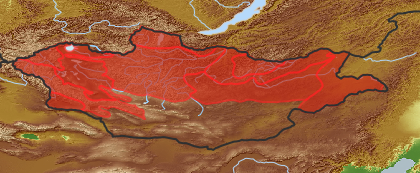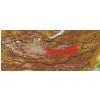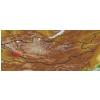| Class: | angiosperms |
| Order: | Saxifragales |
| Family: | Haloragaceae |
| Genus: | Myriophyllum |
| Scientific name: | Myriophyllum verticillatum L. |
| Name acc. to: | Gubanov 1996 |
| Herbar: | list records  |
| Description: | Like M. spicatum but verticils (4)5-6-leaved, 1 pinnate bract per flower and fruitlets small, smooth, rounded at apex. |
| Comments: | No Mongolian material seen.
|
| Link to Flora of China: | http://www.efloras.org/browse.aspx?flora_id=2&name_str=Myriophyllum+verticillatum |
| open map in a new window |  |
| Habitat: | Freshwater lakes and small lakes, backwaters and old river beds (Grubov 2001). |
| Habit (i)general appearance of a plant | |
| Growth form: (i)Herb, shrub, tree or climber. | herb (i)Herbaceous, erect plant, up to 2m high, mostly with a leafy shoot; if perennial, shoots die to the ground each season, shoots are not woody
example: Artemisia pectinata   inherited by genus Myriophyllum: herb inherited by genus Myriophyllum: herb
perennial (i)Living for several to many years, as opposed to annual and biennial  inherited by genus Myriophyllum: perennial inherited by genus Myriophyllum: perennial
|
| Size of plant: (i)Attention: use flowering or fruiting specimens to assess plant height (many biennial plants possess only a basal rosette in the first year). | from 100 mm to 250 mm  inherited by genus Myriophyllum: inherited by genus Myriophyllum:
from 250 mm to 600 mm  inherited by genus Myriophyllum: inherited by genus Myriophyllum:
|
| Parasite status: (i)Is the plant a half- or full parasite? | no parasite/saprophyte (i)Plant fully autonomous, leaves with chlorophyll
example: Most plants, Ranunculus  inherited by family Haloragaceae: no parasite/saprophyte inherited by family Haloragaceae: no parasite/saprophyte
|
| Water or terrestrial plant: (i)Where do the plants grow? | water or swamp plant  inherited by family Haloragaceae: water or swamp plant inherited by family Haloragaceae: water or swamp plant
aquatic, submerged (i)Completely submerged water plant, onlys flowers may appear at the surface
example: Zannichellia  inherited by family Haloragaceae: aquatic, submerged inherited by family Haloragaceae: aquatic, submerged
|
| Leaf (i)expanded, usually photosynthetic organ of a plant (including phylloclades) | |
| Leaf development: (i)Structure and development of leaves. | with green leaves (i)Plant with green leaves  inherited by genus Myriophyllum: with green leaves inherited by genus Myriophyllum: with green leaves
|
| Leaf arrangement: (i)Arrangement of leaves at the stem. | whorled or fascicled (i)Three or more leaves per node or leaves crowded.
example: Galium, Nitraria   inherited by genus Myriophyllum: whorled or fascicled inherited by genus Myriophyllum: whorled or fascicled
|
| Simple or divided leaves: (i)Are the leaves simple or completely divided in several parts? Blade of the leaf entire or (more or less) deeply dissected. Attention: There are various appearances of the leaf margin (from entire to toothed and lobed). Here, we ignore this and ask only for dissections that separate the leaf for more than one third of its length or width, whatever is smaller. Sometimes, it is difficult to tell apart compound leaves from a shoot system with simple leaves: look for stipulae and/or axillary buds at the ground of the leaves: if only some possess these structures, the others are most likely leaflets of a compound leaf. | imparipinnate / ottpinnate (i)A pinnate leaf with an central unpaired terminal leaflet  inherited by genus Myriophyllum: imparipinnate / ottpinnate inherited by genus Myriophyllum: imparipinnate / ottpinnate
compound (i)Composed of several similar parts  inherited by genus Myriophyllum: compound inherited by genus Myriophyllum: compound
pinnate (i)With leaflets on both sides of an axis, at least 2 pairs or more
example: Onobrychis   inherited by genus Myriophyllum: pinnate inherited by genus Myriophyllum: pinnate
|
| Length of leaves: (i)How long is the leaf, be carefull in compound leaves, measure the complete leaf. | from 11 mm to 20 mm  inherited by genus Myriophyllum: inherited by genus Myriophyllum:
|
| Width of leaves: (i)How broad is the leaf, be carefull in compound leaves, measure the complete leaf. | 5-10 mm  inherited by genus Myriophyllum: 5-10 mm inherited by genus Myriophyllum: 5-10 mm
1-3 cm  inherited by genus Myriophyllum: 1-3 cm inherited by genus Myriophyllum: 1-3 cm
|
| Petiole: (i)Leaf divided into stalk (petiole) and blade. | with (i)Leaves with petiole (stalk)   inherited by genus Myriophyllum: with inherited by genus Myriophyllum: with
without (i)Leaves without petiole (stalk), sessile
example: Poaceae, Iris   inherited by genus Myriophyllum: without inherited by genus Myriophyllum: without
|
| Stipule: (i)Leaflets at the base of the petiole, these are smaller and of different shape. | none (i)Without stipules
example: Euphorbia, Ericaceae s.l.  inherited by genus Myriophyllum: none inherited by genus Myriophyllum: none
|
| Leaf colour upper side: (i)Shades of green on the leaf, upper side. | green (i)Clear green
example: Tribulus terrestris  inherited by genus Myriophyllum: green inherited by genus Myriophyllum: green
|
| Leaf colour lower side: (i)Shades of green on the leaf, lower side. | green (i)Clear green, in most species
example: Angelica decurrens  inherited by genus Myriophyllum: green inherited by genus Myriophyllum: green
|
| Leaf veination: (i)Arrangement of the main veins of a leaf. | pinnate (i)One main vein, several side veins, sometimes inconspicuous
example: Cicerbita     inherited by family Haloragaceae: pinnate inherited by family Haloragaceae: pinnate
|
| Flower (i)reproductive portion of the plant, consisting of sepals, petals, stamens, and pistils | |
| Flower appearance and pollination: (i)General appearance of the flower. | not attractive, wind-pollinated or some water plants (i)Small, colourless or green flowers
example: Betula, grasslike plants: Carex, Setaria, Juncus  inherited by genus Myriophyllum: not attractive, wind-pollinated or some water plants inherited by genus Myriophyllum: not attractive, wind-pollinated or some water plants
|
| Perianth arrangement: (i)Attention: in some plants, flowers may be dimorphic in different ways (dioecious or gynodioecious). If flowers vary, record the characters of the most showy flowers. | simple, similar (i)Only one type of perianth leaves (tepals)
example: Tulipa   inherited by genus Myriophyllum: simple, similar inherited by genus Myriophyllum: simple, similar
|
| Diameter of flower: (i)Diameter of flower or flower head. | to 5 mm (i)
example: Aruncus  inherited by genus Myriophyllum: inherited by genus Myriophyllum:
|
| Sepal number: (i)Number of sepal leaves (outer perianth leaves, calyx leaves, mostly greenish). Attention, this character applies only for flowers separated in sepals and petals, thus excluding most monocots. Be aware of the bracts (involucral leaves) of Asteraceae flowerheads, do not qualify these as sepals! Be also aware in Rosaceae is often an epicalyx developed, in this case count all parts. | 4 (i)
example: Sinapis  inherited by genus Myriophyllum: 4 inherited by genus Myriophyllum: 4
|
| Petal / Tepal number: (i)Number of petal leaves (inner perianth leaves, usually coloured). | none or reduced (i)But green sepals may exist
example: Thalictrum  inherited by genus Myriophyllum: none or reduced inherited by genus Myriophyllum: none or reduced
|
| Spur: (i)A hollow, slender, sac-like appendage of the perianth leaves, storing nectar. | no spur (i)Flower without appendage
example: Peganum  inherited by genus Myriophyllum: no spur inherited by genus Myriophyllum: no spur
|
| Sex: (i)Distribution of male and female organs among flowers, only most commonly cases. | unisexual (i)
example: Rhodiola  inherited by genus Myriophyllum: unisexual inherited by genus Myriophyllum: unisexual
monoecious (i)Male and female flowers at the same plant
example: Xanthium, Larix, Atriplex  inherited by genus Myriophyllum: monoecious inherited by genus Myriophyllum: monoecious
dioecious (i)Male and female flowers at different individuals
example: Antennaria  inherited by genus Myriophyllum: dioecious inherited by genus Myriophyllum: dioecious
|
| Inflorescence (i)flowering part of a plant, describes the arrangement of the flowers on the flowering axis | |
| Inflorescence: (i)Structure of the inflorescence. | Flowers in inflorescence (i)No solitary flowers  inherited by genus Myriophyllum: Flowers in inflorescence inherited by genus Myriophyllum: Flowers in inflorescence
Simple inflorescences (i)Flowers sessile on a main shoot or on short to long not branched side shoots
example: Polygonum bistorta    inherited by genus Myriophyllum: Simple inflorescences inherited by genus Myriophyllum: Simple inflorescences
|
| Appearance: (i)Outer look of the inflorescence. | terminal (i)Inflorescence is the highest point of the plant and may consist of a single flower only
example: Cypripedium, Rhaponticum, Ligularia sibirica, Echinops  inherited by genus Myriophyllum: terminal inherited by genus Myriophyllum: terminal
|
| Inflorescence type: (i)Types of inflorescence. Attention: We here ask for the botanical nomenclature of inflorescences, which is sufficiently complicated. Tick only, if you are certain, or tick all inflorescence types that appear similar of these of the plant in question. | spike (spadix) (i)All flowers sessile and crowded along a main axis, there may be several spikes on a shoot; sometimes axis thickened (spadix)
example: Plantago, Carex vesicaria, Vicia, Typha (spadix)    inherited by genus Myriophyllum: spike (spadix) inherited by genus Myriophyllum: spike (spadix)
|
| Root / shoot below ground (i)plant part below ground (in most cases), including below ground shoots, without leaves | |
| Root type: (i)Organisation of the roots. | allorhizous (i)Plant with a conspicuous tap root, one larger tap root with side roots
example: Dicotyledonae  inherited by order Saxifragales: allorhizous inherited by order Saxifragales: allorhizous
|
| Distribution (i)region where the plant is likely to be found | |
| Distribution (Veg. Zones): (i)acc. to Grubov 1952 | Khubsgul (i)In distribution data often named as '1' 
Khentei (i)In distribution data often named as '2' 
Khangai (i)In distribution data often named as '3' 
Mongol-Daurian (i)In distribution data often named as '4' 
Khobdo (i)In distribution data often named as '6' 
Mongolian Altai (i)In distribution data often named as '7' 
Middle Khalkha (i)In distribution data often named as '8' 
East Mongolia (i)In distribution data often named as '9' 
Depression of Great Lakes (i)In distribution data often named as '10' 
Dzungarian Gobi (i)In distribution data often named as '14' 
|
| Distribution Khangay: (i)acc. Flora Khangaya 1989 | III
V
|